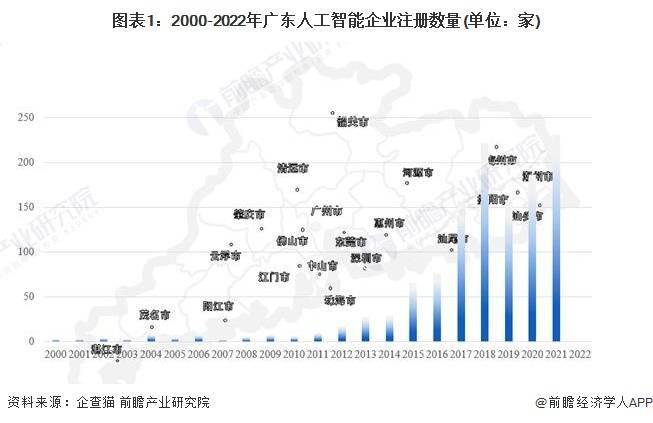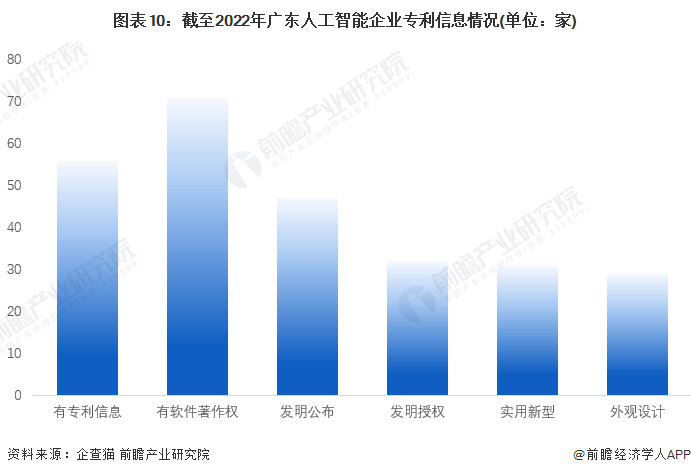 Technology peripherals
Technology peripherals
 AI
AI
 Guangdong Province predicts that the scale of the artificial intelligence industry will exceed 300 billion yuan in 2025, providing big data analysis for artificial intelligence companies
Guangdong Province predicts that the scale of the artificial intelligence industry will exceed 300 billion yuan in 2025, providing big data analysis for artificial intelligence companies
Guangdong Province predicts that the scale of the artificial intelligence industry will exceed 300 billion yuan in 2025, providing big data analysis for artificial intelligence companies

Image source is Photo Network
On November 13, the People's Government of Guangdong Province issued the "Implementation Opinions on Accelerating the Construction of a Leading Place for Innovation in the General Artificial Intelligence Industry" (hereinafter referred to as the "Implementation Opinions") and held a press conference. The document focuses on the innovation and development of Guangdong's general artificial intelligence industry and proposes 22 policy measures, striving to achieve major breakthroughs in computing power, algorithms, data, industry, ecology and other aspects.
The "Implementation Opinions" propose that by 2025, the scale of intelligent computing power will be the first in the country and the world's leading, the general artificial intelligence technology innovation system will be relatively complete, high-level artificial intelligence application scenarios will be further expanded, and the scale of core industries will break through 300 billion yuan, and the number of enterprises exceeds 2,000. In the future, Guangdong will become a national innovation leader in the general artificial intelligence industry, building a national intelligent computing power hub, a data special zone in the Guangdong-Hong Kong-Macao Greater Bay Area, and a national demonstration highland for scenario applications.
──The registration of artificial intelligence companies in Guangdong Province is booming in 2018 and 2021
According to the Chinese enterprise database Qichamao, there are currently 1,240 major companies in Guangdong's artificial intelligence industry, with 2018 and 2021 being the main registration booms. The number of registered artificial intelligence companies in 2018 was 222, and the number of registered companies in 2021 The number is 231.

Artificial intelligence companies in Guangdong Province are mainly registered in Shenzhen and Guangzhou
According to data from the Chinese enterprise database Qichamao, as of the end of April 2022, artificial intelligence companies in Guangdong Province are mainly concentrated in Shenzhen and Guangzhou. Shenzhen has a total of 729 related artificial intelligence companies, while Guangzhou has 230

Artificial intelligence companies in Guangdong Province mainly include limited liability companies and sole proprietorships
According to data from the Chinese enterprise database Qichamao, there are currently 1,086 existing and operating artificial intelligence companies in Guangdong Province. Among them, 1,158 are limited liability companies, accounting for the highest proportion, followed by sole proprietorships, with a total of 339

──Artificial intelligence companies in Guangdong Province are mainly listed on the New Third Board and the New Fourth Board
According to the Chinese enterprise database Qichamao, there are currently 1,086 existing and operating artificial intelligence companies in Guangdong Province, of which 1,082 are unlisted. Overall, the listing rate of Guangdong artificial intelligence companies is 0.4%. Among the listed companies, there are mainly companies on the New Fourth Board and the New Third Board. There are three New Fourth Board companies and one New Third Board company.

There are many artificial intelligence companies in Guangdong Province, including technology-based small and medium-sized enterprises and specialized new enterprises
According to the Chinese enterprise database Qichamao, there are currently 1,086 artificial intelligence companies existing and operating in Guangdong Province, of which 56 companies have patent information and 71 companies have software copyrights. Among the patent information, artificial intelligence companies mainly focus on inventions, with 47 companies having invention information and 32 companies applying for utility models.

IDC predicts that China’s artificial intelligence market will exceed US$14.7 billion in 2023 and will exceed US$26.3 billion by 2026. IDC China Vice President Zhong Zhenshan believes that market growth will mainly come from the replacement of AI applications built in the past few years by applications based on large models, the incremental market brought by generative AI and the new AI-empowered enterprise level application. In the future, the general AI market in the past will become increasingly saturated, making it difficult for manufacturers without large model capabilities to maintain their competitive advantage.
The content that needs to be rewritten is: Forward-looking Economist APP Information Group
Please refer to the "" of the Qianzhan Industry Research Institute to obtain more research and analysis information about this industry
At the same time, Qianzhan Industry Research Institute also provides solutions such as consulting, consulting, etc. Quoting the content of this article in any public information disclosure such as prospectuses and company annual reports requires formal authorization from the Qianzhan Industry Research Institute.
Qianzhan Economist APP provides more in-depth industry analysis, and users can communicate and interact with 500 economists/senior industry researchers
The above is the detailed content of Guangdong Province predicts that the scale of the artificial intelligence industry will exceed 300 billion yuan in 2025, providing big data analysis for artificial intelligence companies. For more information, please follow other related articles on the PHP Chinese website!

Hot AI Tools

Undresser.AI Undress
AI-powered app for creating realistic nude photos

AI Clothes Remover
Online AI tool for removing clothes from photos.

Undress AI Tool
Undress images for free

Clothoff.io
AI clothes remover

AI Hentai Generator
Generate AI Hentai for free.

Hot Article

Hot Tools

Notepad++7.3.1
Easy-to-use and free code editor

SublimeText3 Chinese version
Chinese version, very easy to use

Zend Studio 13.0.1
Powerful PHP integrated development environment

Dreamweaver CS6
Visual web development tools

SublimeText3 Mac version
God-level code editing software (SublimeText3)

Hot Topics
 Bytedance Cutting launches SVIP super membership: 499 yuan for continuous annual subscription, providing a variety of AI functions
Jun 28, 2024 am 03:51 AM
Bytedance Cutting launches SVIP super membership: 499 yuan for continuous annual subscription, providing a variety of AI functions
Jun 28, 2024 am 03:51 AM
This site reported on June 27 that Jianying is a video editing software developed by FaceMeng Technology, a subsidiary of ByteDance. It relies on the Douyin platform and basically produces short video content for users of the platform. It is compatible with iOS, Android, and Windows. , MacOS and other operating systems. Jianying officially announced the upgrade of its membership system and launched a new SVIP, which includes a variety of AI black technologies, such as intelligent translation, intelligent highlighting, intelligent packaging, digital human synthesis, etc. In terms of price, the monthly fee for clipping SVIP is 79 yuan, the annual fee is 599 yuan (note on this site: equivalent to 49.9 yuan per month), the continuous monthly subscription is 59 yuan per month, and the continuous annual subscription is 499 yuan per year (equivalent to 41.6 yuan per month) . In addition, the cut official also stated that in order to improve the user experience, those who have subscribed to the original VIP
 Context-augmented AI coding assistant using Rag and Sem-Rag
Jun 10, 2024 am 11:08 AM
Context-augmented AI coding assistant using Rag and Sem-Rag
Jun 10, 2024 am 11:08 AM
Improve developer productivity, efficiency, and accuracy by incorporating retrieval-enhanced generation and semantic memory into AI coding assistants. Translated from EnhancingAICodingAssistantswithContextUsingRAGandSEM-RAG, author JanakiramMSV. While basic AI programming assistants are naturally helpful, they often fail to provide the most relevant and correct code suggestions because they rely on a general understanding of the software language and the most common patterns of writing software. The code generated by these coding assistants is suitable for solving the problems they are responsible for solving, but often does not conform to the coding standards, conventions and styles of the individual teams. This often results in suggestions that need to be modified or refined in order for the code to be accepted into the application
 Seven Cool GenAI & LLM Technical Interview Questions
Jun 07, 2024 am 10:06 AM
Seven Cool GenAI & LLM Technical Interview Questions
Jun 07, 2024 am 10:06 AM
To learn more about AIGC, please visit: 51CTOAI.x Community https://www.51cto.com/aigc/Translator|Jingyan Reviewer|Chonglou is different from the traditional question bank that can be seen everywhere on the Internet. These questions It requires thinking outside the box. Large Language Models (LLMs) are increasingly important in the fields of data science, generative artificial intelligence (GenAI), and artificial intelligence. These complex algorithms enhance human skills and drive efficiency and innovation in many industries, becoming the key for companies to remain competitive. LLM has a wide range of applications. It can be used in fields such as natural language processing, text generation, speech recognition and recommendation systems. By learning from large amounts of data, LLM is able to generate text
 Can fine-tuning really allow LLM to learn new things: introducing new knowledge may make the model produce more hallucinations
Jun 11, 2024 pm 03:57 PM
Can fine-tuning really allow LLM to learn new things: introducing new knowledge may make the model produce more hallucinations
Jun 11, 2024 pm 03:57 PM
Large Language Models (LLMs) are trained on huge text databases, where they acquire large amounts of real-world knowledge. This knowledge is embedded into their parameters and can then be used when needed. The knowledge of these models is "reified" at the end of training. At the end of pre-training, the model actually stops learning. Align or fine-tune the model to learn how to leverage this knowledge and respond more naturally to user questions. But sometimes model knowledge is not enough, and although the model can access external content through RAG, it is considered beneficial to adapt the model to new domains through fine-tuning. This fine-tuning is performed using input from human annotators or other LLM creations, where the model encounters additional real-world knowledge and integrates it
 Guangdong's cross-city 'subway' opens today: 258 kilometers in length, spanning 5 cities including Guangzhou and Huizhou
Jun 13, 2024 pm 01:46 PM
Guangdong's cross-city 'subway' opens today: 258 kilometers in length, spanning 5 cities including Guangzhou and Huizhou
Jun 13, 2024 pm 01:46 PM
According to news from this website on May 26, at 12 noon today, the Guangzhou-Foshan South Ring Road and the Foshan-Dongguan Intercity Intercity will be officially opened for operation. At that time, they will be connected end-to-end with the already-opened Foshan-Zhaozhou Intercity and Dongguan-Huizhou Intercity, forming a line spanning Guangzhou, There are 258 kilometers of cross-city "subway" in five cities: Foshan, Zhaoqing, Dongguan, and Huizhou. ▲Picture source "Guangdong Intercity" public account, after the opening of the two intercity lines below, the intercity railway mileage operated by Guangzhou Metro Group will reach 318.6 kilometers, with Panyu Station as the center and Guangzhou Intercity to the west , to the east is Guanghui Intercity, connecting Guangzhou, Foshan, Zhaoqing, Dongguan and Huizhou. There are 39 stations on the entire line, including 5 in Guangzhou, 9 in Foshan, 6 in Zhaoqing, 12 in Dongguan, and 7 in Huizhou. The maximum train speed is 200 kilometers per hour. This site includes various sections
 To provide a new scientific and complex question answering benchmark and evaluation system for large models, UNSW, Argonne, University of Chicago and other institutions jointly launched the SciQAG framework
Jul 25, 2024 am 06:42 AM
To provide a new scientific and complex question answering benchmark and evaluation system for large models, UNSW, Argonne, University of Chicago and other institutions jointly launched the SciQAG framework
Jul 25, 2024 am 06:42 AM
Editor |ScienceAI Question Answering (QA) data set plays a vital role in promoting natural language processing (NLP) research. High-quality QA data sets can not only be used to fine-tune models, but also effectively evaluate the capabilities of large language models (LLM), especially the ability to understand and reason about scientific knowledge. Although there are currently many scientific QA data sets covering medicine, chemistry, biology and other fields, these data sets still have some shortcomings. First, the data form is relatively simple, most of which are multiple-choice questions. They are easy to evaluate, but limit the model's answer selection range and cannot fully test the model's ability to answer scientific questions. In contrast, open-ended Q&A
 SOTA performance, Xiamen multi-modal protein-ligand affinity prediction AI method, combines molecular surface information for the first time
Jul 17, 2024 pm 06:37 PM
SOTA performance, Xiamen multi-modal protein-ligand affinity prediction AI method, combines molecular surface information for the first time
Jul 17, 2024 pm 06:37 PM
Editor | KX In the field of drug research and development, accurately and effectively predicting the binding affinity of proteins and ligands is crucial for drug screening and optimization. However, current studies do not take into account the important role of molecular surface information in protein-ligand interactions. Based on this, researchers from Xiamen University proposed a novel multi-modal feature extraction (MFE) framework, which for the first time combines information on protein surface, 3D structure and sequence, and uses a cross-attention mechanism to compare different modalities. feature alignment. Experimental results demonstrate that this method achieves state-of-the-art performance in predicting protein-ligand binding affinities. Furthermore, ablation studies demonstrate the effectiveness and necessity of protein surface information and multimodal feature alignment within this framework. Related research begins with "S
 Five schools of machine learning you don't know about
Jun 05, 2024 pm 08:51 PM
Five schools of machine learning you don't know about
Jun 05, 2024 pm 08:51 PM
Machine learning is an important branch of artificial intelligence that gives computers the ability to learn from data and improve their capabilities without being explicitly programmed. Machine learning has a wide range of applications in various fields, from image recognition and natural language processing to recommendation systems and fraud detection, and it is changing the way we live. There are many different methods and theories in the field of machine learning, among which the five most influential methods are called the "Five Schools of Machine Learning". The five major schools are the symbolic school, the connectionist school, the evolutionary school, the Bayesian school and the analogy school. 1. Symbolism, also known as symbolism, emphasizes the use of symbols for logical reasoning and expression of knowledge. This school of thought believes that learning is a process of reverse deduction, through existing





